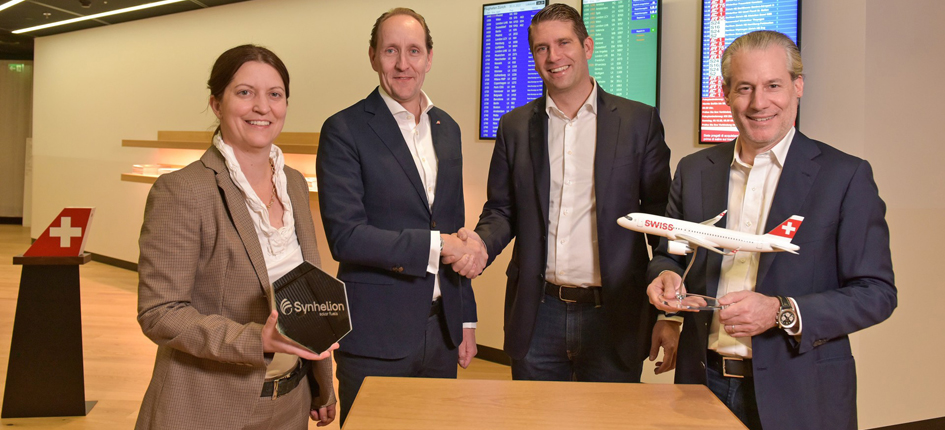Your Green Flight Is Delayed, Not Canceled
Non-carbon aviation fuel is on the tarmac. When can we expect takeoff? Illustration by Adobe
Illustration by Adobe
In early March, a damp and gray week in Zurich, students at the prestigious Swiss Federal Institute of Technology held a “climate strike” inspired by the #Fridaysforthefuture movement. The biggest announcement for the event was written in blue and yellow chalk opposite the school’s Department of Mechanical and Process Engineering, a modern steel-beamed building that hosts a prototype of no small consequence for the post-carbon future the students were demanding. On its top floor sits a parabolic array of mirrors resembling a satellite dish, about five meters in diameter, connected to a reactor capable of concentrating radiation from sunlight by a factor of 3,000, generating temperatures up to 1,500 degrees C, about the point at which iron starts to liquify. Using carbon dioxide and water, the reactor produces a mixture of hydrogen and carbon monoxide known as syngas, which is then converted into a virtually carbon-free form of kerosene.
Its inventors hope that this liquid fuel can be scaled-up into one of the holy grails of renewable energy: a replacement for the petroleum-based combustible fuels responsible for the gigaton-plus tonnes of annual CO2 emitted by the world’s combined aircrafts.
Commercial aviation is responsible for around 2% of global CO2 emissions. While that may seem small compared to the numbers of sectors such as electrification (40%) and agriculture (18%), it amounts to the carbon footprint of three United Kingdoms. (And unlike the UK, it has mostly been moving in the wrong direction for the last two decades.) To meet the goals of the 2015 Paris Agreement, in which nations pledged to keep warming under 1.5 degrees C, the aviation industry as currently configured would need to cut its annual emissions more than 90% by 2050, while also slowing its growth or undertaking expensive carbon dioxide removal, according to the International Council on Clean Transportation, a Berlin-based nonprofit research and advocacy organization.
Given that capitalist enterprises are generally resistant to the idea of slowing their own growth, and considering the high cost of carbon removal, it is not surprising that the industry is touting the development of “sustainable” aviation fuels, or SAFs, which can run in current engines without major adjustments.
Its inventors hope that this liquid fuel can be scaled-up into one of the holy grails of renewable energy: a replacement for the petroleum-based combustible fuels responsible for the gigaton-plus tonnes of annual CO2 emitted by the world’s combined aircrafts.
SAFs emerged as the leading candidates to green aviation through a process of elimination. Batteries are not an option. They work great in cars, but the amount of energy required to lift and propel a jetliner would make them far too heavy. (In an Escherian configuration, you’d need another battery to provide the energy necessary to carry the battery powering the plane, and another one so you could carry that one, and so on.) Hydrogen gas is too diffuse — a plane would need a fuel tank larger than its wings to fly across the continental United States. Liquid hydrogen, meanwhile, is too cold. This leaves liquid SAFs with a similar energy density to fuels currently derived from petroleum. These must also be compatible with existing aircraft, since propellants requiring different engines would force the industry to replace a generation of planes, and asking the low-margin industry to double its largest capital expenditure would throw most airlines into bankruptcy.
Industry and clean energy advocates have united around the promise of such fuels. The development of one or more SAFs, says Pedro Piris-Cabezas, an economist with the Environmental Defense Fund, “has incredible potential to change the nature of flight for the better.”
* * *
There are currently seven types of SAF approved for use. By far the most common is a type of biofuel, produced from waste oils such as old french-fry grease. But there is not now and will never be enough french-fry grease to power all the world’s aircraft. (Probably a good thing from a global public health perspective.) Several other biofuel SAFs produced from feedstocks – farm waste, sewage, even regular trash in dozens of combinations of feedstock and technology – are in development. So-called e-fuels, whereby fuels are derived from processes powered by renewable electricity, are also contending to decarbonize aviation.
They will be needed if the industry is to meet its declared target of using 3 billion gallons of SAF in the U.S. by 2030 — amounting to roughly one-sixth of pre-pandemic annual fuel use. The European Union has set much higher goals: 60% SAF by 2050, nearly half of which must be “of nonbiological origin,” i.e., not made from french-fry grease. The World Economic Forum, meanwhile, recommends countries adopt SAF benchmark requirements to send a demand signal to encourage further investment, support for R&D and subsidies.
Whether aviation can transition to SAFs in the next critical decades is far from certain, however. At the moment, it costs much more than the fossil-fuel stuff — up to six times as much. Industry, energy economists and policymakers agree that the way to make it competitive is to scale it up, as happened with solar panels. Producing something at industrial scale is cheaper per unit than producing it artisanally; and efficiency gains come from the knowledge gained through growing. But there is no getting around the fact that scaling up SAF production will be hugely expensive. To bring aviation in line with the International Energy Agency’s trajectory to net-zero emissions by 2050, the WEF estimates that $175 billion in investment will be required – every year, for the next three decades – to support as many as 3,400 SAF production plants.
The European Union has set much higher goals: 60% SAF by 2050, nearly half of which must be “of nonbiological origin,” i.e., not made from french-fry grease.
As of today, there are just three such plants, all of them in the U.S. Together they produce less than 1% of commercial aviation fuel.
“You can make a most beautiful process — fully circular, only renewable energy,” says Remko Detz, a chemistry Ph.D. who evaluates renewable energy solutions for TNO, the research arm of the Dutch government. “But, in the end, cost determines if you can have a position in the market.”
* * *
The system that ETH Zürich researchers invented is now being commercialized by Synhelion Fuels, a Swiss company based in a low-slung concrete building outside of the city that also houses a CrossFit gym, an indoor playground and a dialysis center. Approaching the company’s lab and workspace, the faint aroma of toast wafts down the hall from the bakery at the supermarket next door.
At the center of the company’s alchemic-seeming project to make fuel from sunlight and CO2 is its handsome, blazer-clad CEO, Phillipp Furler. As a Ph.D. student, he led, with Prof. Aldo Steinfeld, the group that designed the solar plant scale model on the roof at ETH Zürich. His doctoral thesis explored the qualities of various candidate materials — textiles, powders, ceramics — to line the inside of the reactor. After years of experimentation, he finally settled on cerium oxide as optimal for its porosity, which allows it to function as a sort of sponge (for heat, not liquid). As enthusiastic as he is about Synhelion, it’s easy to believe him when he says, as he pulls out a suitcase containing samples of the different candidates he’s tested, “This is what I truly love. Basic research is my passion.”

Such passion has sustained Furler since he began developing the Synhelion system in 2009. He vividly recalls the day five years later that he nervously carried a small container of the first batch, produced at a Royal Dutch Shell research facility in Amsterdam, back to Zürich by train. (Fortunately, dogs at the Swiss border are not trained to sniff for kerosene).
The experimental fuel was a success — a carbon-neutral version of traditional airline fuel — but producing a suitcase of something is a far cry from making enough to power a jetliner, let alone the thousands of routes they fly every day. Industry likes to tout comparative figures with statements claiming this or that company will soon be making “enough SAF to fly to the moon and back 60 times,” but that’s barely enough fuel for a year’s worth of flights from New York to LA. “Scaling up” isn’t just multiplication. Chemistry and mechanics can work very differently at large scale than they do in a lab. This is an old story, told by a large graveyard of companies, each of them confident they could build a better battery for electric vehicles.
“It starts with relatively simple lab experiments,” says Furler. “Then you realize this could work. Then you make it bigger and you make it better.”
Industry likes to tout comparative figures with statements claiming this or that company will soon be making “enough SAF to fly to the moon and back 60 times,” but that’s barely enough fuel for a year’s worth of flights from New York to LA.
When figuring out how to make something new at commercial scale, two costs must be evaluated. The first is capital expenditures, or “capex,” which covers the costs of getting a system up and running, from the purchase of materials to R&D, land and machinery. The second is operating expenditures, or “opex,” which covers the costs to keep the system running. This would include things such as labor, insurance and energy.
Synhelion faced significant challenges in keeping both costs in check. One issue is energy — the ETH system requires a lot of energy to heat the reactor. That sounds like an opex — energy often means fuel — but actually it’s a capex: replicating the satellite dish on the roof in Zürich at large scale. “Because you need to invest a lot of energy, the energy cost really defines, largely, the price of your fuels in the end,” says Furler. “The energy must be super cheap.”
A few dozen square meters of mirrors was never going to suffice to feed a system big enough to make enormous quantities of SAF, so Synhelion developed a thermal-solar system like ones that have long been used (with mixed results) to produce electricity. It invested years of research into getting the arrangement and angles of the mirrors just right.
The opex challenge concerned the heat generated to produce syngas. Running the system constantly would be much cheaper than cranking it up at dawn and shutting it down at dusk. But the sunlight providing the heat only shines strong enough for about a third of the day, even near the equator. This requires storing the heat, which the second law of thermodynamics tells us is not an easy thing to do. “We needed to decouple the generation of the heat from the reaction” that produces syngas, Furler says, and send some of it into storage. To accomplish this, the company developed a ceramic material that holds onto the heat; at night, when the process heat generated in the receiver isn’t driving the reactor, heat is drawn from the thermal energy storage by sending cold steam over the ceramic to heat it before it’s sent to the reactor. “I would say this is one of our biggest strategic advantages,” Furler maintains. “We have a way of efficiently and cheaply storing the renewable energy source.”
The high-temperature process heat isn’t the only ingredient driving the reactor. It also needs carbon, and a water source. The original mission of the ETH research was not only to produce fuel from the sun, but also to efficiently capture CO2 and permanently remove it from the atmosphere.
The CO2-capturing technology is known as Direct Air Capture (DAC). Rather than harnessing the gas where large concentrations are produced, such as the chimneys atop coal-plants and cement factories, DAC uses giant fans to suck up air, filter out everything but the CO2, and turn it into a matter that can’t heat the planet. It was first commercialized by a company called Climeworks in 2021 and remains one of the more reliable forms of offsetting. (You can go to their website right now and pay them to capture some CO2).
DAC requires so much energy that it only saves CO2 if the power driving the fans comes from renewable sources. If that sounds expensive, it is: 1000 euros per metric ton.
DAC requires so much energy that it only saves CO2 if the power driving the fans comes from renewable sources. If that sounds expensive, it is: 1000 euros per metric ton. This is too pricey for Synhelion to use at scale. And getting CO2 from a cement plant or other point source would mean the fuel isn’t carbon-neutral; it’s just making use out of someone else’s pollution, not getting rid of it. For the first industrial plant, Synhelion will solve this by using biogas instead. As with DAC, when Synhelion fuel is burned using biogas, the process only puts into the atmosphere as much CO2 as was removed by the biomass that was converted into the biogas. Synhelion hopes that eventually, DAC will become cheap enough for it to use it instead to produce fuel at a price that airlines are willing to pay.
SWISS, the airline formerly known as Swiss Air, will be the first to use Synhelion solar fuel. Zurich airport has also committed to purchase it. The plan, Furler says, is to meet half of Switzerland’s jet-fuel consumption within the next 10 years, and half of Europe’s by 2040. Its first commercial plant, in Spain, is slated to open in 2025.

* * *
Powering airplanes with french-fry grease would be so much easier. That’s the current state of SAF burned in commercial aviation — HEFA, the technical industry term for fuels produced from old fats. HEFA fuels aren’t exactly carbon-neutral — some CO2 went into the production of the grease — but they represent an 80% improvement over traditional aviation fuel in terms of emissions.
Not all HEFA fuels are produced from used fats, oils and greases. You can also make biofuel HEFAs by clearing a rainforest and planting soybeans or palm oil. If the airline industry were to ramp up its use of biofuels by tearing down and turning up carbon-sequestering trees, soils and peat, the climate benefits of lower-emission fuel could be outweighed by the emissions and avoided sequestration that occurred to produce it.
Ideas for other carbon-neutral fuels abound, each of which takes us farther from existing technology and the needed horizon for scaling them up. At the moment, only HEFA is commercial.
Another company hoping to make SAF is the Chicago-based LanzaJet, spun out of a U.S. Dept. of Energy research lab in 2020. The company says it can produce jet fuel out of ethanol that’s made from trash, industrial off-gasses, agricultural residue or biomass such as wood pellets. It sounds too good to be true, and probably is, because nobody is making affordable ethanol from any of those things. Tantalizing is the prospect of making ethanol from agricultural waste, known as cellulosic ethanol, but here, too, we are so close, yet so far.
“I’ve been saying that cellulosic ethanol is five years away for 15 years,” the head of the Nebraska Farmers Union, John Hansen, once told me, “and I’m not changing my tune now.” That was in 2012. The problem that cellulosic ethanol advocates have yet to overcome is the low energy density of plant matter: You need a literal shit-ton of it to produce 60 gallons, which a 747 burns through every minute.
Fuel from trash is another alluring possibility. England’s Fulcrum Bioenergy and others hope to produce syngas from trash, feeding it into the same Fischer-Tropsch system that Synhelion uses. But other companies have been working to crack the trash-to-gas nut for at least a decade, with little progress.
“Trash is a mix of stuff, a very complex and low-quality feedstock,” says Susan van Dyk, who has advised aircraft manufacturers and research labs and co-authored two reports on SAFs for the International Renewable Energy Agency. “One of the challenges is to remove all the contaminants.”
The problem that cellulosic ethanol advocates have yet to overcome is the low energy density of plant matter: You need a literal shit-ton of it to produce 60 gallons, which a 747 burns through every minute.
United Airlines gave Fulcrum $30 million in 2015 and has yet to see a drop of SAF produced from trash. Now the company is burning through money from the UK government. Its facility outside Liverpool can produce about 2 million gallons of SAF per year but, says van Dyk, “In terms of moving the needle, you [need] tens or hundreds of facilities” its size.
HEFA and fuels from biomass and trash fall under the umbrella category of biofuels. The other subset of SAFs, which includes Synhelion’s solar fuel, is known as synthetic fuel; its tech developed at ETH Zurich was the first to produce carbon-neutral fuel from air and sunlight. Synthetic fuel can also be made by driving an electrolyzer with renewable energy to produce hydrogen, which is then converted (again by Fischer-Tropsch) to a liquid fuel; this is called power-to-liquid, or e-fuel. The last couple of years has seen tremendous acceleration of investment in green hydrogen but the number of large plants in operation remains discouragingly few.
* * *
Remko Detz, the Dutch chemist, echoes Nebraska’s Hansen when he says, “Twenty years ago, they said biofuels will be the future.” What early advocates did not foresee were the “challenges that make it more difficult to deploy at scale.”
Will SAFs share the same fate? Back in 2016, the aviation industry announced a target to cap emissions at 2020 levels, meaning any growth in air travel would be achieved without additional carbon emissions. That didn’t happen. Many of the SAFs it is pinning its hopes on, as we have seen, are the very same biofuels that have proven very slow and very difficult to develop. Though HEFA is commercially available, just 0.1% of jet fuel used today is SAF. (Among some airlines, such as the KLM short-haul subsidiary Transavia, it’s 0.5%).

Though progress has been slow relative to our need for it, Furler believes “the whole field, and also our R&D activity, evolved much better than we thought it would.” Perhaps the major non-technological factor in whether SAF eventually takes off at the scale needed is investment. When Furler started in business 10 years ago, “the pressure from the market side was not really there,” he says. “They’d say, ‘Yeah, this is certainly very interesting research,’ but it was pretty tough to get financing to get larger projects off the ground. That has improved a lot over the last couple of years.” Europe’s Green New Deal, which defined a taxonomy for what qualifies as a green investment, was a big driver. More recently, the U.S. Inflation Reduction Act will likewise incentivize investors.
But will such economic signals be enough? In 2018, Detz co-authored a paper on the possible timeline needed for solar fuels such as Synhelion’s to become cost-competitive with fossil-based kerosene. They made careful and even conservative estimates of the coming investments that might drive progress and lower costs in the near future. It turned out that even those were way over the mark. If he were re-writing the paper today, investment growth would begin exactly where it did five years ago.
“The reality is, nothing happened,” he told me with a shrug.
Your support matters…Independent journalism is under threat and overshadowed by heavily funded mainstream media.
You can help level the playing field. Become a member.
Your tax-deductible contribution keeps us digging beneath the headlines to give you thought-provoking, investigative reporting and analysis that unearths what's really happening- without compromise.
Give today to support our courageous, independent journalists.







And so we build the kind of Bullet Train system that exists in Europe, and then we “only fly” when we’re essentially going cross country and/or across country & an ocean.